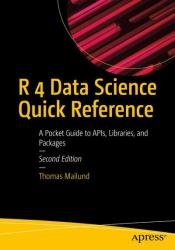 Название: R 4 Data Science Quick Reference: A Pocket Guide to APIs, Libraries, and Packages, 2nd Edition
Название: R 4 Data Science Quick Reference: A Pocket Guide to APIs, Libraries, and Packages, 2nd EditionАвтор: Thomas Mailund
Издательство: Apress
Год: 2022
Страниц: 231
Язык: английский
Формат: pdf (true), epub (true), mobi
Размер: 10.1 MB
In this handy, quick reference book you'll be introduced to several R data science packages, with examples of how to use each of them. All concepts will be covered concisely, with many illustrative examples using the following APIs: readr, dibble, forecasts, lubridate, stringr, tidyr, magnittr, dplyr, purrr, ggplot2, modelr, and more.
With R 4 Data Science Quick Reference, you'll have the code, APIs, and insights to write data science-based applications in the R programming language. You'll also be able to carry out data analysis. All source code used in the book is freely available on GitHub.
R is a functional programming language with a focus on statistical analysis. It has built-in support for model specifications that can be manipulated as first-class objects, and an extensive collection of functions for dealing with probability distributions and model fitting, both built-in and through extension packages.
While there are many data science applications that involve more complex data structures , such as graphs and trees, most bread-and-butter analyses involve rectangular data. That is, the analysis is of data that can be structured as a table of rows and columns where, usually, the rows correspond to observations and the columns correspond to explanatory variables and observations. The usual data sets are also of a size that can be loaded into memory and analyzed on a single desktop or laptop. I will assume that both are the case here. If this is not the case, then you need different, big data techniques that go beyond the scope of this book.
The Tidyverse is a collection of extensions to R: packages that are primarily aimed at analyzing tabular data that fits into your computer’s memory. Some of the packages go beyond this, but since data science is predominately manipulation of tabular data, this is the focus of this book.
What You'll Learn:
Implement applicable R 4 programming language specification features
Import data with readr
Work with categories using forcats, time and dates with lubridate, and strings with stringr
Format data using tidyr and then transform that data using magrittr and dplyr
Write functions with R for data science, data mining, and analytics-based applications
Visualize data with ggplot2 and fit data to models using modelr
Who This Book Is For:
Programmers new to R's data science, data mining, and analytics packages. Some prior coding experience with R in general is recommended.
Скачать R 4 Data Science Quick Reference: A Pocket Guide to APIs, Libraries, and Packages, 2nd Edition